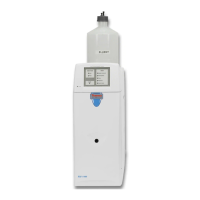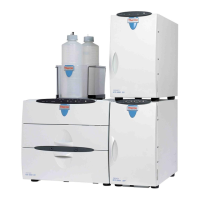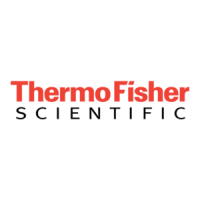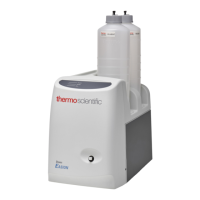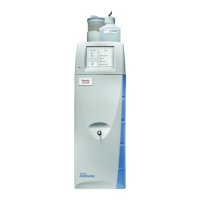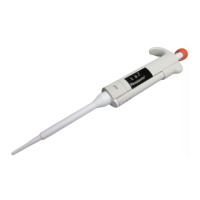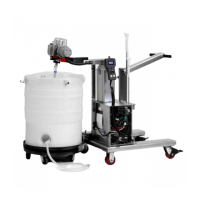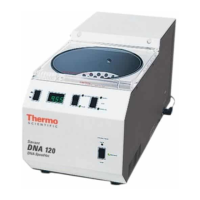Do you have a question about the Thermo Scientific Dionex ICS-1100 and is the answer not in the manual?
Explains ion analysis and the Dionex ICS-1100 system's function and components.
Provides a general description of the Dionex ICS-1100 system, its components, and capabilities.
Details the manual's electronic features and outlines the content of each chapter and appendix.
Covers manufacturing details, intended use, and safety/regulatory compliance labels and standards.
Describes key features of the Dionex ICS-1100, including the front panel, top cover, and component panel.
Illustrates the liquid flow path for standard and RFIC-ER configurations.
Explains control via Chromeleon software, including panel tabsets and software control modes.
Provides detailed descriptions of individual system components.
Presents a flowchart of the basic steps for routine operation of the Dionex ICS-1100.
Details the procedure for powering on the Dionex ICS-1100, computer, and autosampler.
Guides on how to start and connect the Dionex ICS-1100 to the Chromeleon software.
Provides instructions for preparing, degassing, filtering, and filling the eluent reservoir.
Ensures proper filling of the eluent reservoir and secure tubing connections.
Describes the procedure for priming the pump, including line priming and pump head priming.
Covers verifying and setting system operating parameters like flow rate and temperature.
Explains how to equilibrate the system and verify operational status via background conductivity.
Details sample collection, storage, pretreatment, and dilution procedures.
Explains techniques for loading samples via syringe or autosampler and injecting them.
Covers manual and automatic (batch) sample processing steps using Chromeleon.
Outlines routine user-performable maintenance tasks, including daily, weekly, and annual checks.
Explains error message icons, severity levels, and their descriptions within the Audit Trail.
Provides specific troubleshooting steps for various error conditions and messages.
Identifies causes and solutions for leaks in fittings, lines, valves, and pump components.
Addresses issues with pump priming, relating to eluent, degassing, filters, and blockages.
Troubleshoots reasons for the pump failing to start, including power, communication, and settings.
Diagnoses issues causing no flow, such as open valves, unprimed pumps, or broken pistons.
Covers causes of erratic readings, including pump priming, seals, check valves, and leaks.
Addresses high backpressure issues due to restrictions in plumbing or fittings.
Explains extraneous peaks in chromatograms and their causes like contamination or injection issues.
Troubleshoots issues affecting peak reproducibility, such as column overloading or leaks.
Addresses issues causing abnormal retention times or selectivity, like contaminated eluents.
Diagnoses problems with the conductivity cell, including installation and electronics.
Explains causes for high cell output, such as suppressor issues or incorrect calibration.
Covers causes of baseline noise/drift like leaks, trapped gases, contamination, or temperature changes.
Troubleshoots the vacuum degas assembly, focusing on Chromeleon settings and calibration.
Details diagnostic and calibration procedures performed via the Chromeleon Wellness Panel.
Provides methods to identify and isolate restrictions causing excessive system backpressure.
Lists tubing sizes and types, and procedures for replacing tubing and fittings.
Explains the annual recommendation for rebuilding injection and auxiliary valves.
Describes how to replace the mechanical 'pod' of the optional auxiliary valve.
Covers procedures for cleaning or replacing pump check valves to ensure proper operation.
Details the process for replacing pump piston seals and rinse seals.
Explains how to replace a pump piston if seals continue to leak after replacement.
Guides on replacing O-rings in waste or priming valve knobs to fix leaks.
Provides step-by-step instructions for removing and installing a new conductivity cell.
Details the procedure for replacing the suppressor unit with a new one.
Explains the process of removing and installing a new column heater assembly.
Provides instructions for replacing the heat exchanger within the column heater.
Guides on how to safely disconnect and replace the eluent valve.
Details the procedure for replacing the leak sensor if it is faulty.
Covers the two-part procedure for priming the pump, including eluent lines and pump heads.
Describes an alternative priming method using isopropyl alcohol when standard methods fail.
Explains how to safely replace the main power fuses for the instrument.
Lists electrical specifications including main power and fuse requirements.
Details physical characteristics such as dimensions, weight, decibel level, and control modes.
Specifies operating temperature and humidity ranges for the instrument.
Describes front panel indicators like Power LED, Inject Valve LEDs, Alarm LED, and Status LEDs.
Lists specifications for the pump type, construction, pressure, flow rate, precision, and accuracy.
Details specifications for eluent regeneration, including eluents, flow rates, and operation.
Covers specifications for the detector electronics, including type, cell drive, linearity, and resolution.
Lists specifications for the conductivity cell and its heat exchanger.
Specifies details about the injection valve, including type and ports.
Details specifications for the optional auxiliary valve.
Lists specifications for the optional vacuum degas assembly.
Provides specifications for the optional column heater.
Details specifications for various types of suppressors, including capacity and control range.
Lists specifications related to autosampler compatibility and features.
Covers specifications for the system software, including Chromeleon and its features.
Describes the TTL/relay connector strip and pin assignments for external device control.
Explains how to control TTL outputs and relay contacts for external device functions.
Provides guidance on connecting an autosampler to the Dionex ICS-1100.
Instructions on how to print from the Chromeleon software.
Explains factors causing retention time shifts, such as pump flow or column contamination.
Discusses adjusting retention times using Chromeleon parameters for time drifts.
Advises on the frequency of remaking calibration standards.
Provides guidance on how often eluents should be remade.
Instructions on launching the Chromeleon software application.
Explains how to delete sequences or data within Chromeleon.
Details the process for backing up data from Chromeleon.
Describes the procedure for safely shutting down the system.
Provides guidance on the proper method for storing chromatographic columns.
Directs users to column manual troubleshooting for identifying dirty columns.
Refers users to the column manual for instructions on cleaning columns.
Lists common reasons for high conductivity readings, including suppressor and calibration issues.
Refers to a specific manual for configuring and operating the auxiliary valve.
| Type | Ion Chromatography System |
|---|---|
| Technology | Capillary Ion Chromatography |
| Detector | Conductivity Detector |
| Data System | Chromeleon Chromatography Data System |
| Pressure Range | Up to 5000 psi |
| Power Requirements | 100-240 VAC, 50/60 Hz |
| Communication Interface | USB, Ethernet |
| Sample Injection Volume | Up to 25 µL |
| Injection Volume | Up to 25 µL |
| Flow Rate Range | 0.00 to 5.00 mL/min |
